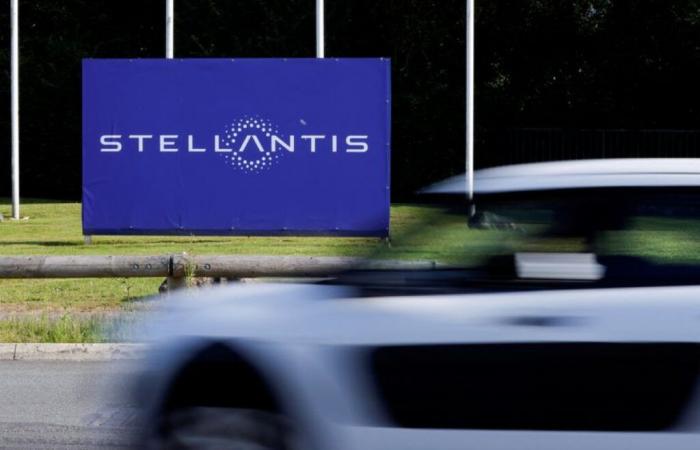
The Stellantis logo at the entrance to the company's factory in Hordain
couple Nora Eckert
Stellantis hopes to negotiate the delicate transition to electric vehicles in the United States with a new platform that can be used indiscriminately for gasoline, hybrid or electric vehicles, a guarantee of flexibility that is all the more important as Donald Trump is preparing to return to the White House.
The Franco-Italian-American manufacturer presented on Tuesday its third new multi-energy architecture, “STLA Frame”, mainly intended to serve as a basis for pick-ups and large SUS very popular across the Atlantic.
But a sign of the turbulence that lies ahead for the energy transition, the automobile manufacturer born from the merger between PSA and FCA has also announced that it is delaying the production of electric pick-ups for its Ram brand.
“We are very focused on executing our plan despite the difficult challenges facing the industry,” Carlos Tavares, chief executive of Stellantis, said in a conference call with reporters.
He explained the shift in production of the electric Ram pickup to the first half of 2025, instead of this year, by the need to guarantee the quality of the model.
“We're just facing a very heavy workload,” he said.
Car manufacturers in Detroit, but also around the world, have launched ambitious 100% battery vehicle programs for two years, but demand for these models is today lower than expected. Of all new vehicles sold in the United States in the first six months of the year, only 8% were purely electric, according to Cox Automotive. Hybrids and plug-in hybrids, where Stellantis is the market leader, did slightly better.
The decision to develop a purely electric platform, or a multi-energy platform, is debated in the automotive industry. In Detroit, Ford Motor is increasingly leaning toward hybrids, while General Motors has shifted its focus to battery models after investing more in its own EV platform. The manufacturer has announced, however, that it will also begin to market plug-in hybrids in 2027.
Stellantis, whose offering in the United States is mainly composed of hybrids, intends to increase its sales of 100% electric cars over the coming years, faithful to its objective of 50% sales of cars and pick-ups in version electricity in the United States by 2030, compared to a target of 100% in the European Union.
The global automobile industry is facing deep uncertainties about the trajectory of electric vehicles, which Donald Trump's victory in the US presidential election has accentuated if he decides to eliminate public aid for the purchase and production of EVs. .
The president-elect's transition team plans to eliminate the $7,500 tax credit for the purchase of an electric vehicle, two sources familiar with the matter told Reuters last week.
Some plug-in hybrids from Stellantis, such as the Jeep Grand Cherokee, were half eligible for this tax credit.
Faced with a decline in sales in North America, until now the most profitable of its regions with best-sellers from the Jeep and Ram brands, general manager Carlos Tavares has reshuffled his management team to try to stem a swelling of stocks and to recover a stock market price at half mast.
Stellantis shares have lost around 42% of their value since the start of the year.
The new platform, designed for pick-ups and which the Ram and Jeep brands will inaugurate, will be added to the “large” and “medium” platforms, already presented for the United States and Europe, as well as to the future “small” platform, dedicated to small cars, this time especially for the European market.
The electric vehicles developed on STLA Frame will have a range of up to 800 km, a load capacity of 6,350 kg and will also be hydrogen compatible, Stellantis said.
(French version Gilles Guillaume, edited by Zhifan Liu)





